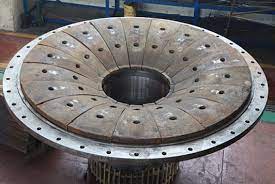End covers play a pivotal role in the safety and performance of ball mills, which are widely used in various industrial processes for grinding materials into fine powders. These components, located at both ends of the mill, serve multiple critical functions that directly impact the efficiency, reliability, and safety of the milling operation. Understanding their importance can help in emphasizing proper maintenance and operational practices. Here’s a detailed look into the critical role of end covers:

Ensuring Structural Integrity
- Sealing the Mill: End covers provide a tight seal for the mill, preventing the escape of material being processed. This sealing is crucial for both environmental control, by preventing dust and particles from escaping into the workplace, and for maintaining the quality of the material being milled by preventing contamination.
- Protection of Internal Components: They protect vital internal components such as gears, bearings, and the grinding media from external contaminants, dust, and debris, which can lead to premature wear or failure.
Safety
- Preventing Ingress: By sealing off the ends of the mill, end covers prevent the ingress of hands or tools during operation, significantly reducing the risk of injury.
- Containment: In the event of a malfunction or breakage of internal components, the end covers help contain these failures, preventing potential injury to operators or damage to other equipment.
Performance Enhancement
- Optimizing Operational Efficiency: Properly designed and maintained end covers contribute to the mill’s overall efficiency. They ensure that the mill operates under the correct pressure conditions and that the milling process is not disrupted by leaks or contamination.
- Heat Management: Some end covers are designed with cooling systems to help manage the heat generated during the milling process. Effective heat management is crucial for maintaining the quality of the product and the longevity of the mill’s components.
Maintenance and Durability
- Ease of Access: End covers are designed for easy removal and installation, allowing for straightforward access to internal components for maintenance, inspection, and replacement. This ease of access is critical for minimizing downtime and ensuring that the mill operates at peak efficiency.
- Wear Protection: The design of the end covers can include wear-resistant linings or coatings to protect against the abrasive action of the materials being processed. This wear protection is essential for extending the lifespan of the mill and reducing maintenance costs.
Operational Stability
- Vibration Reduction: Properly installed and maintained end covers can help in reducing vibration by ensuring that the mill is sealed and aligned correctly. Minimizing vibration is crucial for both the safety of operators and the smooth operation of the mill.
- Noise Reduction: By containing and muffling the noise generated during the milling process, end covers contribute to a safer and more pleasant working environment.
Conclusion
The critical role of end covers in ball mill safety and performance cannot be overstated. They are essential for ensuring the structural integrity of the mill, protecting against contamination, enhancing operational efficiency, and ensuring the safety of personnel. Proper installation, regular inspection, and maintenance of end covers are paramount to maximizing the performance and lifespan of ball mills, underscoring the necessity of adhering to best practices in their management. As such, investing in high-quality end covers and maintaining them properly can lead to significant benefits in terms of productivity, safety, and cost savings.
